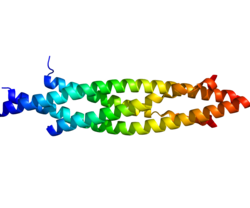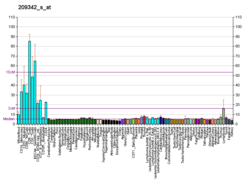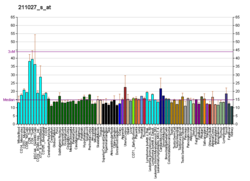IKK2
IKK-β also known as inhibitor of nuclear factor kappa-B kinase subunit beta is a protein that in humans is encoded by the IKBKB (inhibitor of kappa light polypeptide gene enhancer in B-cells, kinase beta) gene.
Function
[edit]IKK-β is an enzyme that serves as a protein subunit of IκB kinase, which is a component of the cytokine-activated intracellular signaling pathway involved in triggering immune responses. IKK's activity causes activation of a transcription factor known as Nuclear Transcription factor kappa-B or NF-κB. Activated IKK-β phosphorylates a protein called the inhibitor of NF-κB, IκB (IκBα), which binds NF-κB to inhibit its function. Phosphorylated IκB is degraded via the ubiquitination pathway, freeing NF-κB, and allowing its entry into the nucleus of the cell where it activates various genes involved in inflammation and other immune responses.
Clinical significance
[edit]IKK-β plays a significant role in brain cells following a stroke.[5] If NF-κB activation by IKK-β is blocked, damaged cells within the brain stay alive, and according to a study performed by the University of Heidelberg and the University of Ulm, the cells even appear to make some recovery.[6]
Inhibition of IKK and IKK-related kinases has been investigated as a therapeutic option for the treatment of inflammatory diseases and cancer.[7] The small-molecule inhibitor of IKK2 SAR113945, developed by Sanofi-Aventis, was evaluated in patients with knee osteoarthritis.[8]
Interactions
[edit]IKK-β (IKBKB) has been shown to interact with
References
[edit]- ^ a b c GRCh38: Ensembl release 89: ENSG00000104365 – Ensembl, May 2017
- ^ a b c GRCm38: Ensembl release 89: ENSMUSG00000031537 – Ensembl, May 2017
- ^ "Human PubMed Reference:". National Center for Biotechnology Information, U.S. National Library of Medicine.
- ^ "Mouse PubMed Reference:". National Center for Biotechnology Information, U.S. National Library of Medicine.
- ^ Herrmann O, Baumann B, de Lorenzi R, Muhammad S, Zhang W, Kleesiek J, et al. (December 2005). "IKK mediates ischemia-induced neuronal death". Nature Medicine. 11 (12): 1322–9. doi:10.1038/nm1323. PMID 16286924. S2CID 28490303.
- ^ "Stroke 'cell-death trigger' found". BBC News. 14 November 2005. Retrieved June 28, 2007.
- ^ Llona-Minguez S, Baiget J, Mackay SP (July 2013). "Small-molecule inhibitors of IκB kinase (IKK) and IKK-related kinases". Pharmaceutical Patent Analyst. 2 (4): 481–98. doi:10.4155/ppa.13.31. PMID 24237125.
- ^ "SAR113945 published clinical trials".
- ^ Asare Y, Campbell-James TA, Bokov Y, Yu LL, Prestel M, El Bounkari O, et al. (August 2020). "Histone Deacetylase 9 Activates IKK to Regulate Atherosclerotic Plaque Vulnerability". Circulation Research. 127 (6): 811–823. doi:10.1161/CIRCRESAHA.120.316743. PMID 32546048. S2CID 219726725.
- ^ a b c Chen G, Cao P, Goeddel DV (February 2002). "TNF-induced recruitment and activation of the IKK complex require Cdc37 and Hsp90". Molecular Cell. 9 (2): 401–10. doi:10.1016/S1097-2765(02)00450-1. PMID 11864612.
- ^ Zandi E, Rothwarf DM, Delhase M, Hayakawa M, Karin M (October 1997). "The IkappaB kinase complex (IKK) contains two kinase subunits, IKKalpha and IKKbeta, necessary for IkappaB phosphorylation and NF-kappaB activation". Cell. 91 (2): 243–52. doi:10.1016/S0092-8674(00)80406-7. PMID 9346241. S2CID 6399108.
- ^ a b Otsuki T, Young DB, Sasaki DT, Pando MP, Li J, Manning A, et al. (2002). "Fanconi anemia protein complex is a novel target of the IKK signalsome". Journal of Cellular Biochemistry. 86 (4): 613–23. doi:10.1002/jcb.10270. PMID 12210728. S2CID 42471384.
- ^ May MJ, D'Acquisto F, Madge LA, Glöckner J, Pober JS, Ghosh S (September 2000). "Selective inhibition of NF-kappaB activation by a peptide that blocks the interaction of NEMO with the IkappaB kinase complex". Science. 289 (5484): 1550–4. Bibcode:2000Sci...289.1550M. doi:10.1126/science.289.5484.1550. PMID 10968790.
- ^ a b c d Woronicz JD, Gao X, Cao Z, Rothe M, Goeddel DV (October 1997). "IkappaB kinase-beta: NF-kappaB activation and complex formation with IkappaB kinase-alpha and NIK". Science. 278 (5339): 866–9. Bibcode:1997Sci...278..866W. doi:10.1126/science.278.5339.866. PMID 9346485.
- ^ a b Deng L, Wang C, Spencer E, Yang L, Braun A, You J, et al. (October 2000). "Activation of the IkappaB kinase complex by TRAF6 requires a dimeric ubiquitin-conjugating enzyme complex and a unique polyubiquitin chain". Cell. 103 (2): 351–61. doi:10.1016/S0092-8674(00)00126-4. PMID 11057907. S2CID 18154645.
- ^ Yeung KC, Rose DW, Dhillon AS, Yaros D, Gustafsson M, Chatterjee D, et al. (November 2001). "Raf kinase inhibitor protein interacts with NF-kappaB-inducing kinase and TAK1 and inhibits NF-kappaB activation". Molecular and Cellular Biology. 21 (21): 7207–17. doi:10.1128/MCB.21.21.7207-7217.2001. PMC 99896. PMID 11585904.
- ^ Lamberti C, Lin KM, Yamamoto Y, Verma U, Verma IM, Byers S, Gaynor RB (November 2001). "Regulation of beta-catenin function by the IkappaB kinases". The Journal of Biological Chemistry. 276 (45): 42276–86. doi:10.1074/jbc.M104227200. PMID 11527961.
- ^ Chariot A, Leonardi A, Muller J, Bonif M, Brown K, Siebenlist U (October 2002). "Association of the adaptor TANK with the I kappa B kinase (IKK) regulator NEMO connects IKK complexes with IKK epsilon and TBK1 kinases". The Journal of Biological Chemistry. 277 (40): 37029–36. doi:10.1074/jbc.M205069200. PMID 12133833.
- ^ a b Wu RC, Qin J, Hashimoto Y, Wong J, Xu J, Tsai SY, et al. (May 2002). "Regulation of SRC-3 (pCIP/ACTR/AIB-1/RAC-3/TRAM-1) Coactivator activity by I kappa B kinase". Molecular and Cellular Biology. 22 (10): 3549–61. doi:10.1128/MCB.22.10.3549-3561.2002. PMC 133790. PMID 11971985.
- ^ Shifera AS, Horwitz MS (March 2008). "Mutations in the zinc finger domain of IKK gamma block the activation of NF-kappa B and the induction of IL-2 in stimulated T lymphocytes". Molecular Immunology. 45 (6): 1633–45. doi:10.1016/j.molimm.2007.09.036. PMID 18207244.
- ^ Vig E, Green M, Liu Y, Yu KY, Kwon HJ, Tian J, et al. (March 2001). "SIMPL is a tumor necrosis factor-specific regulator of nuclear factor-kappaB activity". The Journal of Biological Chemistry. 276 (11): 7859–66. doi:10.1074/jbc.M010399200. PMID 11096118.
- ^ Windheim M, Stafford M, Peggie M, Cohen P (March 2008). "Interleukin-1 (IL-1) induces the Lys63-linked polyubiquitination of IL-1 receptor-associated kinase 1 to facilitate NEMO binding and the activation of IkappaBalpha kinase". Molecular and Cellular Biology. 28 (5): 1783–91. doi:10.1128/MCB.02380-06. PMC 2258775. PMID 18180283.
- ^ Mercurio F, Murray BW, Shevchenko A, Bennett BL, Young DB, Li JW, et al. (February 1999). "IkappaB kinase (IKK)-associated protein 1, a common component of the heterogeneous IKK complex". Molecular and Cellular Biology. 19 (2): 1526–38. doi:10.1128/mcb.19.2.1526. PMC 116081. PMID 9891086.
- ^ Cohen L, Henzel WJ, Baeuerle PA (September 1998). "IKAP is a scaffold protein of the IkappaB kinase complex". Nature. 395 (6699): 292–6. Bibcode:1998Natur.395..292C. doi:10.1038/26254. PMID 9751059. S2CID 4327300.
- ^ Luftig MA, Cahir-McFarland E, Mosialos G, Kieff E (May 2001). "Effects of the NIK aly mutation on NF-kappaB activation by the Epstein-Barr virus latent infection membrane protein, lymphotoxin beta receptor, and CD40". The Journal of Biological Chemistry. 276 (18): 14602–6. doi:10.1074/jbc.C100103200. PMID 11278268.
- ^ Heissmeyer V, Krappmann D, Hatada EN, Scheidereit C (February 2001). "Shared pathways of IkappaB kinase-induced SCF(betaTrCP)-mediated ubiquitination and degradation for the NF-kappaB precursor p105 and IkappaBalpha". Molecular and Cellular Biology. 21 (4): 1024–35. doi:10.1128/MCB.21.4.1024-1035.2001. PMC 99557. PMID 11158290.
- ^ Heissmeyer V, Krappmann D, Wulczyn FG, Scheidereit C (September 1999). "NF-kappaB p105 is a target of IkappaB kinases and controls signal induction of Bcl-3-p50 complexes". The EMBO Journal. 18 (17): 4766–78. doi:10.1093/emboj/18.17.4766. PMC 1171549. PMID 10469655.
- ^ Prajapati S, Verma U, Yamamoto Y, Kwak YT, Gaynor RB (January 2004). "Protein phosphatase 2Cbeta association with the IkappaB kinase complex is involved in regulating NF-kappaB activity". The Journal of Biological Chemistry. 279 (3): 1739–46. doi:10.1074/jbc.M306273200. PMID 14585847.
- ^ Zhang SQ, Kovalenko A, Cantarella G, Wallach D (March 2000). "Recruitment of the IKK signalosome to the p55 TNF receptor: RIP and A20 bind to NEMO (IKKgamma) upon receptor stimulation". Immunity. 12 (3): 301–11. doi:10.1016/S1074-7613(00)80183-1. PMID 10755617.
- ^ Chaudhary PM, Eby MT, Jasmin A, Kumar A, Liu L, Hood L (September 2000). "Activation of the NF-kappaB pathway by caspase 8 and its homologs". Oncogene. 19 (39): 4451–60. doi:10.1038/sj.onc.1203812. PMID 11002417.
- ^ Devin A, Lin Y, Yamaoka S, Li Z, Karin M (June 2001). "The alpha and beta subunits of IkappaB kinase (IKK) mediate TRAF2-dependent IKK recruitment to tumor necrosis factor (TNF) receptor 1 in response to TNF". Molecular and Cellular Biology. 21 (12): 3986–94. doi:10.1128/MCB.21.12.3986-3994.2001. PMC 87061. PMID 11359906.
- ^ Li S, Wang L, Dorf ME (January 2009). "PKC phosphorylation of TRAF2 mediates IKKalpha/beta recruitment and K63-linked polyubiquitination". Molecular Cell. 33 (1): 30–42. doi:10.1016/j.molcel.2008.11.023. PMC 2643372. PMID 19150425.








